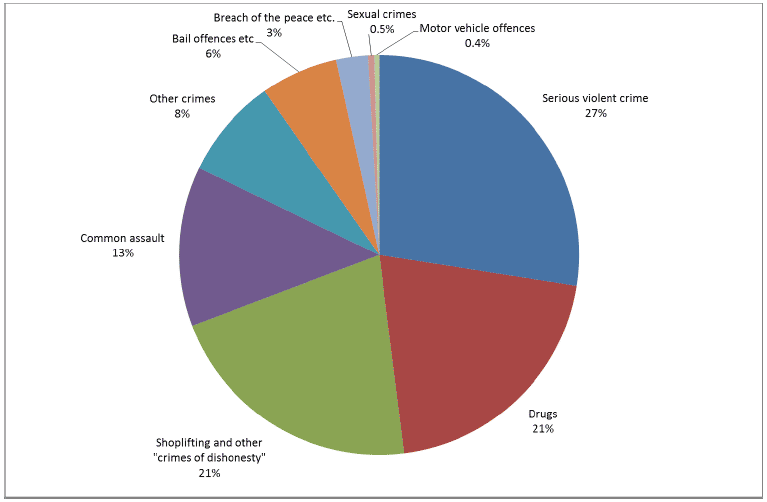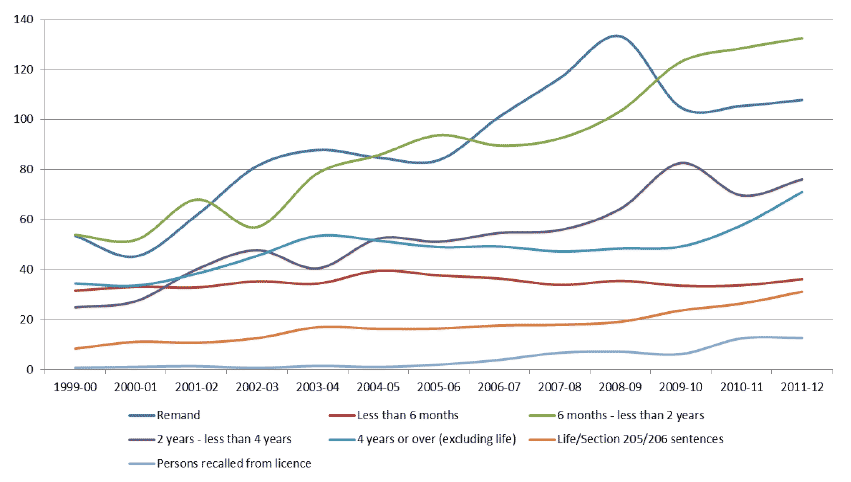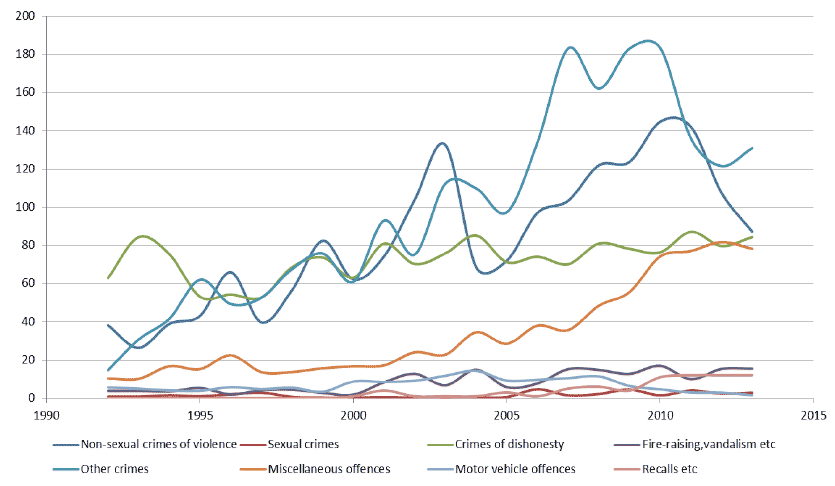International Review of Custodial Models for Women: Key Messages for Scotland
This report summarises some of the international evidence on different approaches to managing women in custody. It was prepared to inform the consultation undertaken by the Scottish Government and the Scottish Prison Service earlier this year in relation to the redesign of the female custodial estate in Scotland.
4.Background and Context
The ICPS (International Centre for Prison Studies) in its most recent international prison population list reports rising female prison populations (over the period of 2000-2011[i]) across all five continents of the world, with the largest increase being in the Americas (where the female prison population has risen by 23% since the last population list published in 2006) and the smallest increase in European countries (6%). Internationally, female prisoners constitute between 2% and 9% of the total prison population. The median level in Europe is 4.9%[9].
More recent international prison statistics from the same organisation (World Prison Brief data) reveal that, alongside England and Wales, Scotland has one of the highest female prison populations in Northern Europe. The female prison population rate (per 100,000 of the national population) is estimated to be approximately 7.1 in Scotland. A similar rate is reported for England and Wales (6.8). However, rates in other Northern European countries are considerably lower. All the Scandinavian countries have female imprisonment rates of under 4.5, with Denmark reported to have the lowest rate (2.5) (of the selected countries in Table 1). With the exception of Denmark and the Netherlands, the rate of female imprisonment has increased in all listed countries over the past 15 years. Other countries covered in this report are included in Table 1 for reference.
| Country | Year | Number of female prisoners |
Percentage of total prison population |
Female prison population rate (per 100,000 of national population) |
Trend (Female prison population rate in 2000) |
|---|---|---|---|---|---|
| United States | 2013 | 205,400 | 9.3% | 64.6 | 55.6 |
| Spain | 2015 | 4,982 | 7.7% | 10.7 | 9.1 |
| Canada | 2012 | NK | NK | 10.6 | NK |
| Scotland | 2015 | 383 | 5.2% | 7.1 | 4.0[ii] |
| England and Wales | 2015 | 3,922 | 4.6% | 6.8 | 6.4 |
| Germany | 2015 | 3,753 | 5.9% | 4.6 | 4.3 |
| Finland | 2015 | 234 | 7.5% | 4.3 | 2.7 |
| Norway | 2015 | 217 | 5.8% | 4.2 | 3.3 |
| Netherlands | 2013 | 687 | 5.4% | 4.1 | 7.7 |
| Sweden | 2014 | 326 | 5.6% | 3.4 | 3.2 |
| France | 2015 | 2,183 | 3.3% | 3.3 | 3.0 |
| Northern Ireland | 2015 | 54 | 3.2% | 2.9 | 1.4 |
| Ireland | 2015 | 124 | 3.3% | 2.7 | 2.2 |
| Denmark | 2015 | 139 | 4.0% | 2.5 | 3.1 |
Table 1. World Female Prison Population Rates 2015 (compiled for selected countries from data available on the ICPS World Prison Brief website August 2015[10]) [iii]
The female prison population in Scotland
The (average daily) female prison population in Scotland is approximately 400[iv], with about 315 sentenced prisoners and approximately 85 on remand.
The female prison population represents approximately 5.5% of the total prison population[11]. The number of female prisoners, however, is growing at a faster rate than their male counterparts, and the number of female offenders in Scottish prisons has practically doubled over the past ten years.
In terms of throughput, there are about 3000 receptions to prisons per annum, of which almost two thirds are for remand[v].
It is commonly reported that women tend to commit economically-motivated crimes (e.g. to support drug use or cope with poverty) which are often of an acquisitive nature, e.g. shoplifting[12],[13]. Recent Scottish Government analysis of prison population data suggests that although low-level crimes (such as shoplifting, common assault, bail offences and breach of the peace) account for the majority (79%) of convicted crimes resulting in a prison sentence, of the 315 sentenced prisoners, serious violent crime and drugs offences account for nearly 50% of the population (but only 15% of convictions) . This is because of different lengths of sentences, meaning that those serving longer sentences (for serious crimes) make up more of the average daily prison population (see Figure 1).

Figure 1 - Female Prison Population by Crime Type
Of those sentenced to custody in 2013-14, 76% of females received a tariff of 6 months or less (compared to 66% of males)[14]. However, this only accounts for 10% of the sentenced female prison population. By contrast, sentences of two years plus account for around 50% of the prison population, but only 5% of sentences.
There is some evidence that women are being imprisoned for longer periods; research conducted by the SCCJR (The Scottish Centre for Crime and Justice Research)[15] noted a particular increase in sentences between six months and two years. Similarly, Scottish Government analysis of the female prison population shows that over the past 10 years the sharpest increase in custodial convictions (by sentence length) is for sentences between six months and two years, and two years and four years. There has also been a marked growth in remand prisoners, and to a lesser extent in sentences of four years and over. In contrast, the proportion of short sentences resulting in a custodial sentence has remained fairly stable (see Figure 2).

Figure 2 - Female Prison Population by Sentence Length
Growth in female prison population
The total prison population has increased substantially since the 1990s, and has more than doubled over the past 15 years. However, there has been a slight decline in the population since 2011/12.
The growth in the female prison population appears to have been driven by increases custodial convictions for serious violent crime, drugs offences (primarily supply), and common assault. Crimes of dishonesty, such as shoplifting, have remained broadly stable (see Figure 3). This appears to be fairly consistent with other Western countries, such as the US (and the UK as a whole) which have also seen a rise in female drug-related incarcerations. Godin & Kendall (2009[16]), for example, noted that in the UK, it has risen 223% between 1991 and 2001 (compared with 74% for men over the same period).

Figure 3 - Growth in Female Prison Population by Crime Type
Whilst there were 1,206 custodial convictions in 2013-14, only 634 individual women were involved, primarily due to some people being convicted of numerous different offences at the same time.
Of these individuals, around 40% had no previous custodial convictions, and around 20% had no previous convictions whatsoever. Overall reconviction rates and return to custody rates for women are slightly lower than those of men, with about 45% of those leaving custody being reconvicted within a year[vi]. About 25% return to custody within a year. Reconviction rates are lower for older women (over 40) (29%), first time prisoners (21%), and first time offenders (9%).
Acquisitive crimes, whilst being relatively low-level offences, are strongly associated with recidivism (Ministry of Justice, 2014[17]). Within Scotland, in 2011-12, 55% of those convicted of shoplifting were subsequently reconvicted within one year, with most of these reconvictions being for further crimes of dishonesty[18].
The female custodial estate in Scotland
There is one women-only prison in Scotland - HMP Cornton Vale - which holds the majority of female prisoners (219). Some women are also held at HMP Edinburgh (96), HMP Greenock (53), and HMP Grampian (49)[vii].
In the UK, the Corston Report[19] in 2007, and in Scotland, the Angiolini Report[20] in 2012, both made recommendations for improving the lives of women prisoners and reducing the female prison population. The Angiolini Report included recommendations for a smaller replacement national prison for serious offenders, with women on remand or serving short sentences to be held in local prisons to enhance family and community links and reintegration. This was envisaged in the report by adapting the existing estate (HMP Edinburgh, HMP Grampian, the new HMP Inverclyde and potentially HMP Low Moss). The report also recommended increased use of video conferencing and gender specific training (Part 7: Prisons).
Since then, the plans for the new women's prison at Inverclyde have been reconsidered with the focus now on a more community-based approach.
International evidence on penal policy for women consistently emphasises the importance of addressing the particular (and multiple) needs of women in custody in a holistic and coordinated way. It is widely recommended that all women's needs, in particular criminogenic needs[viii], should be addressed in custody and beyond (e.g. physical and mental health, substance abuse, education, employment, parenting, finances, housing and psychological wellbeing[21]).
Much of the research on managing women offenders suggests that a gender specific approach is central to achieving better outcomes for women[22]. This may take the form of gender-specific assessment/classification methods, staff training and female staffing levels[ix]. Some other key principles of best practice highlighted in the literature[23],[24],[25] are:
Empowerment and efficacy
- Approaches that empower women to change and promote self-efficacy
- Approaches that encourage self-knowledge and improved self-esteem
Relationships/connections with others
- Approaches that promote healthy relationships between women prisoners, significant others (especially their children) and the wider community
Integrated services
- Interventions which adopt a holistic approach to address multiple needs
- Support provided in custody is available in the community ensuring continuity of care on release (with an emphasis on healthcare provision)
Individual prisons in Australia have developed their own philosophies on the treatment of women in custody. For example, the Boronia Pre-release Centre in Western Australia's guiding principles focus on women's responsibility - for themselves, their family and the community. The four principles are: personal responsibility and empowerment (e.g. providing women with choices about what they do), family responsibilities (e.g. maximising family contact in a child-friendly environment), community responsibility (e.g. working with and for the community and gaining new skills), and lastly, respect and integrity (e.g. cultural and gender-appropriate services). Boronia has a strong emphasis on education and throughcare, and has continued to lower its recidivism rates[26].
In Scandinavian countries, the principle of normality[x]
is central to its penal policy. The idea of 'normalisation' is that prison life should resemble life outside prison as far as possible. In practice this means that women undertake meaningful activities whilst in custody ( e.g. work, education), take responsibility for themselves ( e.g. purchasing and cooking their food) and retain connections with their family and local communities. The purpose of normalisation is to facilitate successful rehabilitation and reintegration and reduce the negative impacts of imprisonment.There is an increasing emphasis being placed on the value of education for women in custody, and the importance of women having the opportunity to undertake purposeful activities. For example, a number of prisons in Australia[xi] have been praised for their introduction of a 'structured day' regime. In Bandyup Prison, for example, women undertake meaningful activity for five hours per day, five days a week. The activities from which they can choose include work, education, programmes, visits, medical appointments, recreation and personal time. Women are rewarded for their participation in activities via a gratuity system[27].
The UN Rules for the Treatment of Women Prisoners and Non-custodial Measures for Women Offenders (the Bangkok Rules), adopted by the United Nations in July 2010, are a set of international standards governing the treatment of women in prison and non-custodial alternatives. The rules set out the specific needs of women in relation to families, support, reintegration and previous abuse and vulnerability. The key principles are:
'Gender-specific options for diversionary measures and pre-trial and sentencing alternatives shall be developed within Member States' legal systems, taking account of the history of victimization of many women offenders and their caretaking responsibilities'.
'Women offenders shall not be separated from their families and communities without due consideration being given to their backgrounds and family ties. Alternative ways of managing women who commit offences, such as diversionary measures and pre-trial and sentencing alternatives, shall be implemented wherever appropriate and possible.'[28]
There are a number of other international standards which apply to the UK in relation to female offenders. A good summary of these can be found in the Prison Reform Trust (2013) report (pp5-7) [29].
Contact
Email: Tamsyn Wilson
There is a problem
Thanks for your feedback